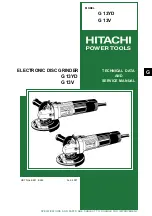
--- 5 ---
HITACHI
G 13V (dial: 1)
B2 (dial: 1)
HITACHI
G 13V (dial: 1)
B1, B2 (dial: 6)
HITACHI G 13YD
G 13V (dial: 6)
HITACHI
G 13YD, G 13V (dial: 6)
Rotation speed of spindle
B2 (dial: 1)
B1, B2 (dial: 6)
10,000
8,000
6,000
4,000
2,000
0
Rotation speed of spindle (/min)
Stator coil temp
. r
ise (k)
Load
G 13V, B2
Dial: 6
• • •
Maximum speed
Dial: 1
• • •
Minimum speed
Stator coil temp. rise
200
100
0
Fig. 3 Comparison in torque vs. rotation speed and stator coil temperature rise (G 13YD, G 13V)
Fig. 3 indicates:
(1) Because the Models G 13YD and G 13V are equipped with high-power motors and improved cooling
mechanisms, the stator coil temperature rise is lower than that of B1 and B2 at the same torque and the
motors are resistant to be burnt out.
(2) The rotation speed of the Models G 13YD and G 13V is higher than that of B1 and B2 at the same torque
under heavy load conditions. This shows that the Models G 13YD and G 13V ensure excellent performance.
6-2. Comparisons in Torque vs. Rotation Speed and Stator Coil Temperature Rise
Fig. 3 shows comparisons of the rotation speed and the stator coil temperature rise between some competitive
models with respect to torque. Torque represents the magnitude of load, i.e., the amount of pressing force,
cutting depth and forward force in actual cutting jobs. This shows that a powerful motor has both a minimum drop
of rotation speed even at a higher torque and a lower stator coil temperature rise at the same torque.























